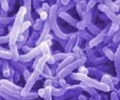An expert from Tel Aviv University's School of Physics and Astronomy has developed a new system that can help monitor the safety of a building or community's water supply in real time, by watching it in the same way as a snake does.
Prof. Abraham Katzir's work attains significance because, according to him, ordinary tap water may become deadly within minutes out of contamination due to industrial spillage, natural disaster or sabotage.The researcher modified special fibres developed in his Tel Aviv University lab, and found that he could detect "colours" in the infrared spectrum which distinguish between pure and contaminated water.
He points out that this spectrum is not visible to the naked eye, for it can be seen only by certain animals, like snakes or vampire bats, to track down prey.
Connected to a commercial infrared spectrometer, the fibres serve as sensors that can detect and notify authorities immediately if a contaminant has entered a water reservoir, system, building or pipeline.
Prof. Katzir has revealed that experiments conducted in the lab showed that the fiberoptic system could detect poisons like pesticides in amounts well below the World Health Organization safety threshold.
The researcher reveals that placed in a stream of flowing water, a sensor head provides real-time quality analysis.
Advertisement
"It's unlikely that someone will poison the water supply in Afghanistan, but America is in grave danger and needs to arm itself against chemical threats to its drinking water," says Prof. Katzir.
Advertisement
He says that such an instrument can be used to detect hazardous chemicals, pollutants and threats in the water, "seeing" water in the same way as a snake does.
"Toxic materials are readily available as pesticides or herbicides in the agriculture industry, and can be harmful if consumed even in concentrations as low as few parts per million," says Prof. Katzir.
Preliminary field experiments have already been done at several European sites, the results of which were recently reported in the Journal of Applied Spectroscopy.
Source-ANI
LIN















